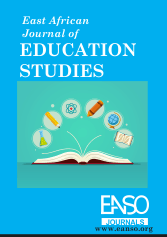Constraints of English Teaching Proficiency on Students’ Mastery of English Language Skills in Community Secondary Schools in Morogoro District Council
Abstract
This study focused on investigating the Constraints of English teaching proficiency on students’ mastery of English language skills in community secondary schools in Morogoro District Council. The study used case study research design and mixed research approach. The targeted populations in this study were ward education officers, School head masters, English teachers, and students from 5 rural community secondary schools in Morogoro district council. Sample size for this study was 130 respondents. Purposive sampling technique was applied in selecting Ward education officers and school head masters and simple random sampling technique was used in selection of students and English teachers. Collected data were analyzed using descriptive statistics and thematic analysis. The findings emphasize that low teaching proficiency is a significant factor contributing to poor student performance in community secondary schools. The overuse of code switching, although aimed at aiding comprehension, may negatively impact students’ English language development. Improving teachers’ proficiency is crucial for enhancing students’ communication skills and overall academic performance. The results emphasize the need for targeted professional development to address teaching deficiencies and support better educational outcomes. To address these challenges, educational institutions should invest in professional development programs that enhance teachers’ English proficiency and reduce code switching. Regular assessments of teaching effectiveness and the integration of language support tools will further improve instructional quality and boost students’ academic performance
Downloads
References
Dearden J (2014). English as the medium of instruction – a growing global phenomenon. University of Oxford: British council.
Harmer, j. (2000). The practice of English language teaching. London: Longman Group limited.
Makuwa, D.K (2004). The SACMEQII report: A study of the conditions of schooling and the quality of primary education in Namibia. Windhoek: Ministry of Basic Education, Sport and Culture.
Ministry of Education and Culture (MOEC). (1995). Education and Training Policy. Government of Tanzania.
Mwamkoa, C. (2020). The Challenges of English Language Proficiency in Tanzanian Secondary Schools. Tanzania Journal of Education, 12(1), 45-60.
Mwinsheikh. H. (2008). Overcoming the language barrier. Anan depth study of the strategies used by Tanzania secondary schools’ science teachers and students in coping with English –Kiswahili dilemma. In M. Qorro, Z.Desai. & B.Brock-Utne(Eds.).Dar es salaam.
Powell, K. C. & Kalina, C. J. (2009). Cognitive and social constructivism: Developing tools for effective classroom. Education, Florida Atlantic University, 130(2), 241-250.
Richards JC (2015). Key issues in Language Teaching. Cambridge: Cambridge university press.
Swila, I.N (2009). Language of instruction in Tanzania: Contradiction between ideology, policy and implementation. African study, Monographs, 30(1)1-14.
Vygotsky, L. S. (1978). Mind in Society: The Development of Higher Psychological Processes. Harvard University Press.
Wood, D., Bruner, J. S., & Ross, G. (1976). The Role of Tutoring in Problem Solving. Journal of Child Psychology and Psychiatry, 17(2), 89-100.
Copyright (c) 2024 Seif M. Abdallah, Peter T. Mramba, PhD

This work is licensed under a Creative Commons Attribution 4.0 International License.




























